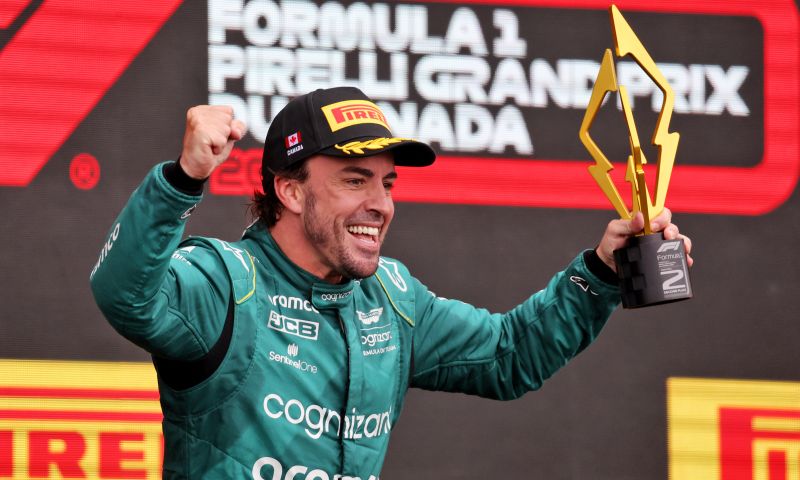Analysis | Alonso and Stroll duel at Aston Martin
Column

Since the start of the season, Canadian Lance Stroll has been decidedly slower than team-mate Fernando Alonso. While the Spaniard has scored podiums and points for Aston Martin, Stroll has been unable to steal points from Mercedes and Ferrari, the Silverstone-based squad's main rivals.
Since the start of the season, Canadian Lance Stroll has been decidedly slower than team-mate Fernando Alonso. While the Spaniard has scored podiums and points for Aston Martin, Stroll has been unable to steal points from Mercedes and Ferrari, the Silverstone-based squad's main rivals.
Alonso is very strong in the race
Since the first Grand Prix of the season, the gap between Alonso and Stroll has been wide. Too much one could say. Stroll, under normal race conditions, has finished with a significant delta with his team-mate ranging from +15.865s off the Spaniard in Bahrain to +54.832s in the Canadian Grand Prix.
Although it has to be taken into consideration that judging the margins between the two in the first three races of the season can be tricky. The Canadian raced with broken wrists in Bahrain, had a mechanical retirement in Jeddah and the Albert Park race ended under a safety car. Ironically, the smallest break was experienced in Bahrain.
It's a question of skill
Taking the fastest laps of each driver in the three Grands Prix of Azerbaijan, Monaco and Canada, it is possible to take stock of the performances of both drivers aboard the AMR23. Only these Grands Prix were taken into account because these races saw a solid enough parity of conditions to make the analysis.
The fastest laps of both show significant differences in favour of the Spaniard with deltas ranging from +1.386 seconds in Azerbaijan to +1.283 seconds in Monaco. In Canada, we again find a delta of a significant magnitude of +0.875 tenths of a second. But where does Alonso gain time?
The Spaniard has a versatile and dynamic style that allows him to drive as his race requires. On some of his fastest laps, he brakes earlier in a particular corner. In the same corners, on other laps, he only lifts his foot off the accelerator a little, but not necessarily to save fuel. With this, the Spaniard could be looking to change the balance of the car in a much gentler way.
This could also help him to better position the car to enter the corners with a better angle of attack and exit them a little straighter in order to have a better exit by being able to apply the power earlier. This driving style is more geometric and tends to be gentler on the tyres.
But, on other laps, Alonso is able to take the car and squeeze every last tenth out of it, which shows the confidence he has in his car and his own ability to control it.
Stroll doesn't seem to have the authority that the Spaniard has aboard the AMR23. The Canadian loses out to his team-mate when braking later and earlier, and is only able to overtake him on the straights. This is because Alonso runs with slightly more downforce. But while the Canadian is able to exceed Alonso's top speed by up to 17kph, it is not enough to make up all the time he loses in the corners, which is where, inevitably, most of the lap time is gained or lost.
Consistency rules in F1
Alonso has a mechanical consistency. He is able to clock laps at very close times one after the other. And while Stroll also boasts a good level of consistency, it just isn't as precise or as fast as the Spaniard.
Taking the race in Canada, for example, where the Canadian finished +54.832s behind Alonso, the Spaniard was quicker lap after lap, even as he mitigated a suspected Aston Martin problem. The Spaniard spent a 27-lap period driving between the high 1:15s and low 1:16s with the exception of three laps. Stroll was lapping in the high 1:16s and low 1:17s, being between 0.6 tenths of a second to almost 2 seconds slower than the Spaniard.
Stroll just isn't that quick
With an average speed difference of 0.988kph in Alonso's favour over the 1,535.119km run this season, it is impossible to deny the Spaniard's dominance over Stroll. Under normal circumstances, the smallest difference between the two has been 0.55kph, in Bahrain.
But, since Azerbaijan (with the exception of Spain), this average has not dropped below 1.05kph, peaking at 1.88kph at the Canadian Grand Prix so far this season. This means that for every hour of running, Alonso has taken from one kilometre to almost two kilometres off the pace in three of the last four Grands Prix.
In fact, Stroll, at the Miami Grand Prix, had an average speed of 208.56kph, identical to Yuki Tsunoda's 208.56kph at AlphaTauri. In Canada, he barely matched Alfa Romeo's 192.73 kph and McLaren's 192.70 kph. The latter was dented by the five seconds that were added to the final race time of Lando Norris, who finished ahead of Stroll.
The AMR23 is a complex and aerodynamically challenging car, and the way it distributes uses and interprets airflow is truly fascinating. However, it only seems to shine in all its glory in the hands of a huge Fernando Alonso. So what does the two-time Spanish world champion have to say about it?
Fernando the goody-goody or Fernando the champion?
Fernando Alonso has often been empathetic towards Lance Stroll in the media, saying the Canadian needs consistency, time and confidence. However, are these statements genuine, or is the Spaniard trying to maintain the current status quo, with himself as Aston Martin's unquestioned leader in the quest for his third world title?

